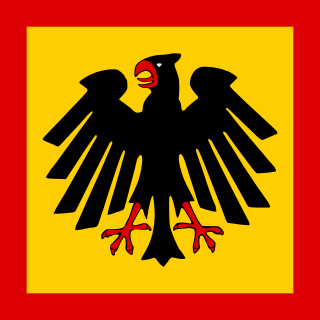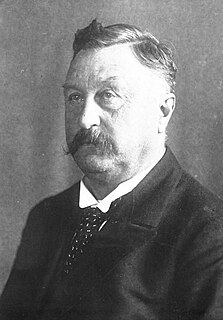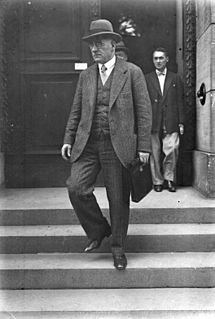
Hermann Müller (help·info) was a German Social Democratic politician who served as Foreign Minister (1919–1920), and twice as Chancellor of Germany in the Weimar Republic. In his capacity as Foreign Minister, he was one of the German signatories of the Treaty of Versailles in 1919.

The Reichspräsident was the German head of state under the Weimar constitution, which was officially in force from 1919 to 1945. In English he was usually simply referred to as the President of Germany. The German title Reichspräsident literally means President of the Reich, the term Reich referring to the federal nation state established in 1871.

The Bavarian People's Party was the Bavarian branch of the Centre Party, a lay Roman Catholic party, which broke off from the rest of the party in 1918 to pursue a more conservative and more Bavarian particularist course. The party displayed monarchist leanings because many Bavarians had never accepted the overthrow of the House of Wittelsbach in 1918 and there was a period of near separatism in the early 1920s, culminating in Gustav von Kahr's unwillingness to abide by rulings from Berlin during the autumn crisis of 1923. This only came to an end with the shock of Adolf Hitler's Beer Hall Putsch. Following the establishment of a more stable situation throughout Germany, the party came around to a more moderate line under the leadership of Ministerpräsident Heinrich Held and party president Fritz Schäffer.
The Weimar Coalition is the name given to the centre-left to center-right coalition of the Social Democratic Party of Germany (SPD), the social liberal German Democratic Party (DDP) and the Christian democratic Centre Party, who together had a large majority of the delegates to the Constituent Assembly that met at Weimar in 1919, and were the principal groups that designed the constitution of Germany's Weimar Republic. These three parties were seen as the most committed to Germany's new democratic system, and together governed Germany until the elections of 1920, when the first elections under the new constitution were held, and both the SPD and especially the DDP lost a considerable share of their votes. Although the Coalition was revived in the ministry of Joseph Wirth from 1921 to 1922, the pro-democratic elements never truly had a majority in the Reichstag from this point on, and the situation gradually grew worse for them with the continued weakening of the DDP. This meant that any pro-republican group that hoped to attain a majority would need to form a "Grand Coalition" with the conservative liberal German People's Party (DVP).
In the thirteen years the Weimar Republic was in existence, some forty parties were represented in the Reichstag. This fragmentation of political power was in part due to the peculiar parliamentary system of the Weimar Republic, and in part due to the many challenges facing German democracy in this period.

The 1932 German presidential elections were held on 13 March and 10 April. They were the second and final direct elections to the office of President of the Reich (Reichspräsident), Germany's head of state under the Weimar Republic. The incumbent President, Paul von Hindenburg, first elected in 1925, was re-elected to a second seven-year term of office. His major opponent in the election was Adolf Hitler of the Nazi Party (NSDAP).

The Weimar National Assembly was the constitutional convention and de facto parliament of Germany from 6 February 1919 to 6 June 1920. The assembly drew up the new constitution which was in force from 1919 to 1933, technically remaining in effect even until the end of Nazi rule in 1945. It convened in Weimar, Thuringia and is the reason for this period in German history becoming known as the Weimar Republic.

Cabinet Müller I or the first Cabinet Müller was the third democratically elected government of Germany and the second in office after the Weimar Constitution came into force in August 1919. It was named after the new Chancellor (Reichskanzler) Hermann Müller of the Social Democratic Party of Germany (SPD). The cabinet was based on the same three centre-left parties as the previous one: the SPD, the German Center Party (Zentrum) and the German Democratic Party (DDP). It was formed in March 1920 after the resignation of the Cabinet Bauer. The Cabinet Müller resigned in reaction to the outcome of the Reichstag elections of 6 June 1920.

The Fehrenbach cabinet was the fourth democratically elected Reichsregierung of the German Reich. It was named after Reichskanzler (chancellor) Konstantin Fehrenbach and took office on 25 June 1920 when it replaced the First Müller cabinet.

The First Wirth cabinet was the fifth democratically elected Reichsregierung of the German Reich. It was named after Reichskanzler (chancellor) Joseph Wirth and took office on 10 May 1921 when it replaced the Fehrenbach cabinet.

The Second Wirth cabinet was the sixth democratically elected Reichsregierung of the German Reich, during the period in which it is now usually referred to as the Weimar Republic. The cabinet was named after Reichskanzler (chancellor) Joseph Wirth and took office on 26 October 1921 when it replaced the First Wirth cabinet.

The Second Stresemann cabinet was the ninth democratically elected Reichsregierung of the German Reich, during the period in which it is now usually referred to as the Weimar Republic. The cabinet was named after Reichskanzler (chancellor) Gustav Stresemann and took office on 6 October 1923 when it replaced the First Stresemann cabinet which had resigned on 3 October. Stresemann's second cabinet resigned on 23 November 1923 and was replaced on 30 November by the first cabinet under chancellor Wilhelm Marx.

The First Marx cabinet was the tenth democratically elected Reichsregierung of the German Reich, during the period in which it is now usually referred to as the Weimar Republic. The cabinet was named after Reichskanzler (chancellor) Wilhelm Marx and took office on 30 November 1923 when it replaced the Second Stresemann cabinet which had resigned on 23 November. Marx' first cabinet resigned on 26 May 1924 and was replaced on 3 June by another cabinet under his chancellorship.

The Second Marx cabinet was the 11th democratically elected Reichsregierung of the German Reich, during the period in which it is now usually referred to as the Weimar Republic. The cabinet was named after Reichskanzler (chancellor) Wilhelm Marx and took office on 3 June 1924 when it replaced the First Marx cabinet which had resigned on 26 May. Marx' second cabinet resigned on 15 December 1924 and was replaced on 15 January 1925 by a cabinet led by Hans Luther.

The First Luther cabinet was the 12th democratically elected Reichsregierung of the German Reich, during the period in which it is now usually referred to as the Weimar Republic. The cabinet was named after Reichskanzler (chancellor) Hans Luther and was in office for only a year. On 15 January 1925 it replaced the Second Marx cabinet which had resigned on 15 December 1924. Luther resigned with his cabinet on 5 December 1925 following the signature of the Locarno treaties but remained in office as caretaker. He formed another government on 20 January 1926.

The Second Luther cabinet was the 13th democratically elected Reichsregierung of the German Reich, during the period in which it is now usually referred to as the Weimar Republic. The cabinet was named after Reichskanzler (chancellor) Hans Luther and was in office for not quite four months. On 20 January 1926 it replaced the First Luther cabinet which had resigned on 5 December 1925. Luther resigned as chancellor on 13 May 1926. His cabinet remained in office as a caretaker government until 17 May 1926, but was led by Otto Gessler in its final days. On 17 May, Wilhelm Marx formed a new government, virtually unchanged from the second Luther cabinet except for the departure of Luther.

The Third Marx cabinet was the 14th democratically elected Reichsregierung of the German Reich, during the period in which it is now usually referred to as the Weimar Republic. The cabinet was named after Reichskanzler (chancellor) Wilhelm Marx and was in office for only seven months. On 17 May 1926 it replaced the Second Luther cabinet after the resignation of Hans Luther on 13 May 1926. Marx resigned with his cabinet on 17 December 1926 but remained in office as caretaker. He formed another government on 29 January 1927.

























